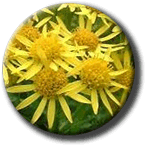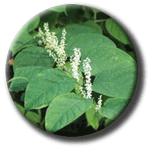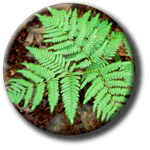Naturenet: Weeds
Weeds
Noxious or otherwise
W
eeds! Every gardener’s nightmare. Also a problem for the countryside
manager. Although it is rarely the first option, weed control is still a necessary
activity in many places - either because of invasive introduced species, or
because of natural species which don't co-exist happily with the way we want
to use our land. There are a number of plants which are regularly controlled
and which have various bits of law attached to them. This page tries to simplify
the maze with some straightforward advice and links to more information.
 What
a lot of fuss is made over the humble ragwort! It's a natural part of the British
ecosystem, but it does have a habit of invading overgrazed pasture, and if
horses (in particular) eat it, it has a long-term poisonous effect and can
even kill them. It also affects other grazing livestock. Because people like
and value horses there are often campaigns and exhortations to 'root out ragwort',
and even some optimistic souls asserting that it can be eradicated - which
is neither possible nor desirable. Without doubt, though, some degree of control
is a good idea. What is less helpful is some anti-ragwort campaigners repeating
dubious statements such as suggesting that ragwort can kill a horse without
even growing in its field, or that there has been some sort of recent 'plague'
of ragwort, or that ragwort population is anything to do with cinnabar moths
- none of these are true, and these and similar alarmist claims only serve
to confuse the conscientious landowner who wants to know what to do about the
weed.
What
a lot of fuss is made over the humble ragwort! It's a natural part of the British
ecosystem, but it does have a habit of invading overgrazed pasture, and if
horses (in particular) eat it, it has a long-term poisonous effect and can
even kill them. It also affects other grazing livestock. Because people like
and value horses there are often campaigns and exhortations to 'root out ragwort',
and even some optimistic souls asserting that it can be eradicated - which
is neither possible nor desirable. Without doubt, though, some degree of control
is a good idea. What is less helpful is some anti-ragwort campaigners repeating
dubious statements such as suggesting that ragwort can kill a horse without
even growing in its field, or that there has been some sort of recent 'plague'
of ragwort, or that ragwort population is anything to do with cinnabar moths
- none of these are true, and these and similar alarmist claims only serve
to confuse the conscientious landowner who wants to know what to do about the
weed.
It's often said that it's illegal to have ragwort growing
on your land. it isn't. Under the Weeds
Act 1959 the Secretary of State may
serve an enforcement notice on the occupier of any land on which injurious
weeds are growing, requiring the occupier to take action to prevent the spread
of injurious weeds. If the landowner dosn't clear up the weeds, the government
can do it for them, and charge them. So it's not actually illegal.
The Weeds Act specifies five injurious weeds: common ragwort, spear thistle,
creeping or field thistle, broad-leaved dock and curled dock. Ragwort is by
far the most common and significant of these. The government department that
has the enviable job of serving these notices is DEFRA. However, they do not
act on every case, and indeed they are not obliged to do so. Their policy is
that a priority will only be given to complaints where weeds are threatening
land used for:
- Keeping or grazing horses and other livestock, or
- Farmland used to produce conserved forage (e.g. hay or silage), or
- Other agricultural activities, and;
- The complainant has made reasonable efforts to contact the landowner or
occupier where the weeds are growing.
So, not only is it not illegal to have ragwort on your land, but unless it
is directly threatening to spread onto agricultural land, nobody will do anything
about it. Where there is a risk that injurious weeds may spread to land which
is not farmland there is no legal remedy under the Weeds Act. The best way
forward is for the complainant to discuss the problem with the occupier of
the infested land. They may be able to work together to achieve a satisfactory
outcome. Ultimately, however, if this is not possible, an occupier of land
under threat from weeds may need to consider civil action through the courts
- pretty unlikely to achieve much.
There's much more information available from
DEFRA (see link below) but in short, you can pull it up, cut it or poison it.
- Pulling will never eradicate it, but it will control it if you do it every
single year. If you leave off for a year, it will come back even worse than
ever as pulling can make it easier for ragwort to colonise if it is started
and then stopped.
- Cutting it is dangerous if you leave it to lie, as the cut weed is more
palatable to livestock. So don't cut it in a field you will graze. Again,
it has no long-term effect.
- Poisoning it can eliminate it but is pricy and needs to be done by a qualified
person. Don't try this unless you know what you are doing.
Whatever method you use, you will need to do it again and again. Also, if
you don't get the management of the land right (usually introducing less intensive
grazing and reducing supplementary feeding) you will never control it either.
Good pasture management which keeps the grass sward tight will minimise the
chance of ragwort establishing.
DEFRA: weeds page
Ragwort Control Act 2003
Ragwort Facts: dispels some bizarre
myths about ragwort, and gives good references.
 Knotweed is an invasive introduced plant that colonises waterways and woodlands,
and pushes out native wildlife. It gets to be very tall, forms dense stands,
and is an impressive sight. Originally a garden plant, it now gets everywhere
and is a nuisance particularly as its strong roots can break through concrete
and damage buildings. It's particularly problematic in the West Country and
Wales.
Knotweed is an invasive introduced plant that colonises waterways and woodlands,
and pushes out native wildlife. It gets to be very tall, forms dense stands,
and is an impressive sight. Originally a garden plant, it now gets everywhere
and is a nuisance particularly as its strong roots can break through concrete
and damage buildings. It's particularly problematic in the West Country and
Wales.
Like ragwort, it's not actually illegal to have knotweed
on your land. But it's not a good idea. In the UK there are two main pieces
of legislation that cover Japanese Knotweed. These are:
- The Wildlife
and Countryside Act 1981
 . Knotweed is on Schedule
9
. Knotweed is on Schedule
9 , Section
14 of the Act. It is an offence to actively plant or otherwise cause the
species to grow in the wild. But it's not actually illegal to have it on
your land, nor is there any specific law against allowing it to spread, although
doing so could be a nuisance.
, Section
14 of the Act. It is an offence to actively plant or otherwise cause the
species to grow in the wild. But it's not actually illegal to have it on
your land, nor is there any specific law against allowing it to spread, although
doing so could be a nuisance.
- The Environmental Protection Act 1990. Japanese Knotweed
is classed as ‘controlled
waste’ and as such must be disposed of safely at a licensed landfill
site according to the Environmental Protection Act (Duty of Care) Regulations
1991. Soil containing knotweed roots can be regarded as contaminated and,
if taken off a site, must be disposed of at a suitably licensed landfill
site and buried to a depth of at least 5 m.
If you have a neighbour who has knotweed and it is spreading onto your land,
it would be a very good idea to take action before it gets near your buildings.
Start with friendly discussions, but if that goes nowhere, it might be time
to consult your buildings insurance company (some will act for you in such
matters) or a solicitor.
There's only really one thing to do: poison
it. No other method really works, and anything involving digging or cutting
has such a high risk of spreading the plant it's probably not worth it. A bit
of plant the size of a postage stamp can sprout into a whole clump within a
single growing season. Application of glyphosate (Round-up) can control it
if you are lucky, but for anything more than a few stems you really need to
get qualified help in to do it properly. Unfortunately it is a hard plant to
poison, and often resists applications effectively. Commercial herbicides are
stronger than those bought over the counter and a trained operative will know
the best way to get at this particularly difficult plant.
Environment Agency: knotweed page
Cornwall Knotweed Forum:
good general information too
Devon CC knotweed page
 Another native species, in days gone by bracken was harvested extensively for
fire-lighters and animal bedding. But with the change in agricultural patterns
and harvesting, now in some places, especially heathland and moorland, bracken
can be an invasive species which out-competes many other scarcer plants.
Thus it is often the target of control activity.
Another native species, in days gone by bracken was harvested extensively for
fire-lighters and animal bedding. But with the change in agricultural patterns
and harvesting, now in some places, especially heathland and moorland, bracken
can be an invasive species which out-competes many other scarcer plants.
Thus it is often the target of control activity.
There is no legal obligation to control bracken and there
is no particular legislation about it.
Generally, bracken problems tend to be on large
areas, and so the solutions are often large scale -including ariel spraying,
burning, ploughing and many other methods. If you want to do this, you need
more technical advice than we can offer. However, for small-scale bracken control
pulling and crushing are moderately effective. Both need to be carried out
for many seasons to exhaust the rhizomes, and in some places spraying with
herbicide can be effective, but as bracken is usually in a place where other
species grow you should definitely get a professional to do this if you chose
the chemical option.
Bracken and health: bracken contains cancer-causing chemicals, and the stems
can very easily cut the hands. So wear gloves when pulling or handling it,
and don't eat it. There was a time when people working in bracken areas wore
masks to avoid breathing in the spores, but this is now uncommon as the risk
of harm is known to be very low.
SEPA
leaflet: very comprehensive - PDF file (500kb).
RSPB
advice.

 What
a lot of fuss is made over the humble ragwort! It's a natural part of the British
ecosystem, but it does have a habit of invading overgrazed pasture, and if
horses (in particular) eat it, it has a long-term poisonous effect and can
even kill them. It also affects other grazing livestock. Because people like
and value horses there are often campaigns and exhortations to 'root out ragwort',
and even some optimistic souls asserting that it can be eradicated - which
is neither possible nor desirable. Without doubt, though, some degree of control
is a good idea. What is less helpful is some anti-ragwort campaigners repeating
dubious statements such as suggesting that ragwort can kill a horse without
even growing in its field, or that there has been some sort of recent 'plague'
of ragwort, or that ragwort population is anything to do with cinnabar moths
- none of these are true, and these and similar alarmist claims only serve
to confuse the conscientious landowner who wants to know what to do about the
weed.
What
a lot of fuss is made over the humble ragwort! It's a natural part of the British
ecosystem, but it does have a habit of invading overgrazed pasture, and if
horses (in particular) eat it, it has a long-term poisonous effect and can
even kill them. It also affects other grazing livestock. Because people like
and value horses there are often campaigns and exhortations to 'root out ragwort',
and even some optimistic souls asserting that it can be eradicated - which
is neither possible nor desirable. Without doubt, though, some degree of control
is a good idea. What is less helpful is some anti-ragwort campaigners repeating
dubious statements such as suggesting that ragwort can kill a horse without
even growing in its field, or that there has been some sort of recent 'plague'
of ragwort, or that ragwort population is anything to do with cinnabar moths
- none of these are true, and these and similar alarmist claims only serve
to confuse the conscientious landowner who wants to know what to do about the
weed. Knotweed is an invasive introduced plant that colonises waterways and woodlands,
and pushes out native wildlife. It gets to be very tall, forms dense stands,
and is an impressive sight. Originally a garden plant, it now gets everywhere
and is a nuisance particularly as its strong roots can break through concrete
and damage buildings. It's particularly problematic in the West Country and
Wales.
Knotweed is an invasive introduced plant that colonises waterways and woodlands,
and pushes out native wildlife. It gets to be very tall, forms dense stands,
and is an impressive sight. Originally a garden plant, it now gets everywhere
and is a nuisance particularly as its strong roots can break through concrete
and damage buildings. It's particularly problematic in the West Country and
Wales. Another native species, in days gone by bracken was harvested extensively for
fire-lighters and animal bedding. But with the change in agricultural patterns
and harvesting, now in some places, especially heathland and moorland, bracken
can be an invasive species which out-competes many other scarcer plants.
Thus it is often the target of control activity.
Another native species, in days gone by bracken was harvested extensively for
fire-lighters and animal bedding. But with the change in agricultural patterns
and harvesting, now in some places, especially heathland and moorland, bracken
can be an invasive species which out-competes many other scarcer plants.
Thus it is often the target of control activity.